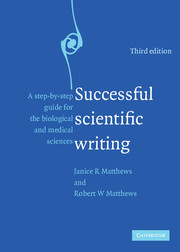Book contents
- Frontmatter
- Contents
- Preface
- Preface to the third edition
- 1 PREPARING TO WRITE
- 2 COMPOSING A FIRST DRAFT
- 3 VISUAL SUPPORT FOR THE WRITTEN WORD
- 4 VISUAL SUPPORT FOR THE SPOKEN WORD
- 5 REVISING TO INCREASE COHERENCE
- 6 IMPROVING WORD CHOICE, AND SYNTAX STYLE
- 7 ATTENDING TO GRAMMAR, NUMBERS, AND OTHER MECHANICS
- 8 THE REST OF THE STORY
- Appendix 1 Suggested responses to exercises
- Appendix 2 Excerpts from “Uniform requirements for manuscripts submitted to biomedical journals: Writing and editing for biomedical publication”
- Selected resources
- Index
4 - VISUAL SUPPORT FOR THE SPOKEN WORD
- Frontmatter
- Contents
- Preface
- Preface to the third edition
- 1 PREPARING TO WRITE
- 2 COMPOSING A FIRST DRAFT
- 3 VISUAL SUPPORT FOR THE WRITTEN WORD
- 4 VISUAL SUPPORT FOR THE SPOKEN WORD
- 5 REVISING TO INCREASE COHERENCE
- 6 IMPROVING WORD CHOICE, AND SYNTAX STYLE
- 7 ATTENDING TO GRAMMAR, NUMBERS, AND OTHER MECHANICS
- 8 THE REST OF THE STORY
- Appendix 1 Suggested responses to exercises
- Appendix 2 Excerpts from “Uniform requirements for manuscripts submitted to biomedical journals: Writing and editing for biomedical publication”
- Selected resources
- Index
Summary
How can I know what I've said until I see what I'm saying?
Visual communication has both a verbal component – usually visual presentation of the written word – and an illustrative component such as drawings, diagrams, photos, and charts. Although both elements have long received attention in the context of the primary research article, scientific writing instruction has tended to treat other avenues of visual communication as a relatively minor afterthought. The implicit assumption has been that oral presentations and posters, for example, involve only minor repackaging of a written document and its supporting graphics. In recent years, however, this assumption has been challenged by new developments that have increased the status of visual communication and given it a surprisingly powerful role to play in modern scientific exchanges.
First, there is an increased understanding that when people look at a visual pattern, they process it differently than text (Gurak, 2000). Humans read each word of text and decipher it, but they quickly and efficiently perceive visual information as a unit. (How many times have you tried to assemble something and after puzzling over the written instructions, found yourself turning to the diagram?)
Second, communication has become increasingly international, with the outcome that science and technology must be accessible to people across a variety of languages. The use of symbols rather than written words can make concepts understandable around the world. At the same time, web publishing has given visual communication much greater force and international presence.
- Type
- Chapter
- Information
- Successful Scientific WritingA Step-by-Step Guide for the Biological and Medical Sciences, pp. 79 - 102Publisher: Cambridge University PressPrint publication year: 2007

